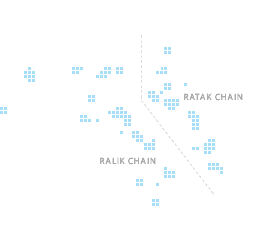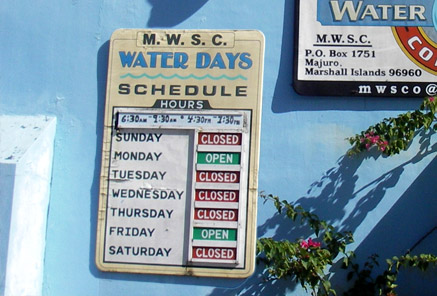Majuro Water Resources Situation Assessment, Republic of the Marshall Islands

|
||||||||

The Marshall Islands is one of only four atoll nations on our planet, with a maximum elevation above sea level of only a few meters. By this very nature freshwater supply is limited to groundwater from underlying lenses, and rainwater harvesting. During climatic extremes like El Nino periods, desalination is an option that has been sourced through different aid agencies. Desalination needs a lot of energy and Marshall Islands relies totally on imported fuel for power generation, making the process too expensive and unsustainable in the long term.
These facts may lead you to believe that water demand management is a high priority at the national level in the Marshall’s. Unfortunately this is not so. During a scoping mission to Majuro by SOPAC in August 2006 several options for improvement were discovered *.
There is a lack of data and data -collection, -analysis and data storage options. The main utility, Majuro Water and Sewerage Company, (MWSC) are under-resourced in terms of both staff and finance, and training and capacity building needs are high. Their own legislation is weak and there is no overall water sector strategy for Majuro or other islands in the republic. These are some of the issues that, together with urbanisation, population growth, and resulting increased vulnerability from natural and man-made hazards, make minimising water losses a high priority.
By comparing the amount of water supplied against invoices for water received and paid for it is estimated that the leakage in Majuro’s water supply system could be around 50%. This is a very rough estimate and an unknown but assumingly large amount disappears through illegal offtakes. The NZAID funded Water Demand Management program has so far facilitated the participation of the Manager and one engineer from the utilities in Majuro and Ebeye to participate in a Water Loss Workshop held in Pohnpei in October 2007. The Marshall Islands have also access to their own leak detection equipment and a lap top to help out with data collection and to serve as a backup storage facility for water related information. In the near future it is hoped that, with the cooperation of MWSC the installation of new flow meters and loggers to monitor the whole reticulation system can be executed. Based on findings from the data collected so far it is further hoped to create a System Loss Management Plan in order to assist Majuro, and the Marshall Islands in general, to improve the management of this most precious resource; freshwater.
* (SOPAC EDF9 Reducing Vulnerability of Pacific ACP States – Republic of Marshall Islands KRA2 Technical Report No 86)

















